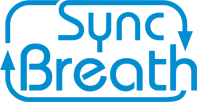Breathing while exercising
Most of the anaerobic exercises I practice are a series of movements in which I breathe mixed, consciously and unconsciously. I focus more on moving or holding the postures than on my breathing.
When I move my body by stretching, bending, twisting, etc., my ‘breathing app’ adapts spontaneously to my activity. For example, some postures restrict my lung expansion, and others allow my lungs to expand freely. My ‘breathing app’ gets information from the stretch sensors in my lungs and factors in the information when sending the activation signals to my breathing muscles.
I begin to feel that I have mastered a physical exercise once it’s clear to me how to breathe from start to finish. In any case, parallel execution of movement and conscious breathing requires practice.
Having an awareness of my breathing while exercising has many advantages. However, if I need to ‘look for my breath and find it,’ it may reduce the effectiveness of the exercise.
Breathing with and against the movement
With
Typically, breathing with the movement means that:
- I tend to exhale when closing, twisting, bending, or folding toward my body.
- I tend to inhale when opening, untwisting, erecting, or unfolding away from my body.
Against
Breathing against the movement is when I do the exact opposite of breathing ‘with the movement.’ It also has merits; it stretches and pulls the lungs. This ‘anti-motion’ is an essential part of various breathing practices.
Some physical exercises have a completely different effect on me, depending on whether my lungs are full or empty, or if I’m breathing with or against my movement while exercising.
A long exhalation with the movement while assuming a posture, allows me to ‘melt’ into the pose. But I pay attention not to ‘over-melt’ to the point of discomfort. After ‘melting,’ when my lungs are empty, I ‘expand’ into the posture as I start inhaling. The melting and subsequent expansion cause an incremental stretch, improving body elasticity. That’s a good way to advance stretching abilities gradually and safely.
Settling, expanding, melting, and timing
There are many posture exercises I want to practice daily, but unfortunately, time is a limited resource. So, when exercising, I try to spend my time wisely and in a way my body can accommodate. I feel well when I hold many postures (for a shorter duration) daily rather than holding a small number of postures for longer durations.
For many years, I limited my posture-holding duration to 10 seconds. I had no convincing argument for why I kept a posture for 10 seconds, apart from the fact that I was taught to think in decimals and have been doing it that way for many years. I used head counting (21, 22, 23, and so on) to assess the time.
Later, I discovered that instead of counting, I could efficiently use my ‘breathing clock’ to determine the duration of many of my posture exercises.
When exercising, I focus either on holding a posture or focus on a motion. Here’s how it works.
Melting
When I move my body parts and transition from one posture to the next, I do it on a single exhale. It’s much easier for me to make a uniform and long transition between postures when making an extended, controlled exhale. I settle in the wanted posture once I complete the exhaling.
After settling in, I inhale and expand my ribcage. Next, I exhale deep and slow. The exhale allows me to ‘melt’ into the posture. I try to let my breathing determine the intensity and duration of my stretching. The deeper I exhale, the more I ‘melt’ into the posture. I avoid repeated rocking or successive tilting of my body while I hold the posture.
The following inhale allows me to ‘expand’ into the posture. This breath-led expansion enables a gradual exit from the ‘melting’ before releasing the posture and transitioning to the next.
Motion
When motion is the focus of an exercise (not the posture holding), I inhale at the start, transition during a single long exhale, and inhale after completing the transition.
Breathing while the focus is on posture-holding
- My lungs are inflated following the end of the previous exercise.
- Exhale, transition, and settle into a posture.
- Inhale and expand my ribcage.
- Exhale and melt into the posture.
- Inhale fairly fully and expand out of the posture.
Breathing while the focus is on motion
- My lungs are inflated following the end of the previous exercise.
- Inhale fairly fully.
- Exhale slowly.
- Inhale fairly fully.
